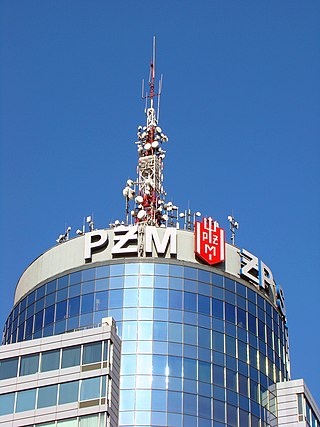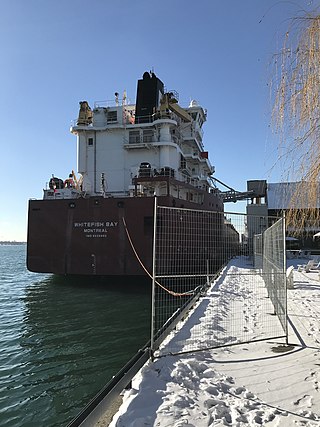
The St. Lawrence Seaway is a system of locks, canals, and channels in Canada and the United States that permits oceangoing vessels to travel from the Atlantic Ocean to the Great Lakes of North America, as far inland as Duluth, Minnesota, at the western end of Lake Superior. The seaway is named for the St. Lawrence River, which flows from Lake Ontario to the Atlantic Ocean. Legally, the seaway extends from Montreal, Quebec, to Lake Erie, and includes the Welland Canal. Ships from the Atlantic Ocean are able to reach ports in all five of the Great Lakes, via the Great Lakes Waterway.

Canada Steamship Lines (CSL) is a shipping company with headquarters in Montreal, Quebec, Canada. The business has been operating for well over a century and a half.

A cargo ship or freighter is a merchant ship that carries cargo, goods, and materials from one port to another. Thousands of cargo carriers ply the world's seas and oceans each year, handling the bulk of international trade. Cargo ships are usually specially designed for the task, often being equipped with cranes and other mechanisms to load and unload, and come in all sizes. Today, they are almost always built of welded steel, and with some exceptions generally have a life expectancy of 25 to 30 years before being scrapped.

A merchant ship, merchant vessel, trading vessel, or merchantman is a watercraft that transports cargo or carries passengers for hire. This is in contrast to pleasure craft, which are used for personal recreation, and naval ships, which are used for military purposes.

A bulk carrier or bulker is a merchant ship specially designed to transport unpackaged bulk cargo—such as grain, coal, ore, steel coils, and cement—in its cargo holds. Since the first specialized bulk carrier was built in 1852, economic forces have led to increased size and sophistication of these ships. Today's bulk carriers are specially designed to maximize capacity, safety, efficiency, and durability.

Lake freighters, or lakers, are bulk carrier vessels that operate on the Great Lakes of North America. These vessels are traditionally called boats, although classified as ships.

The modern terms short-sea shipping, marine highway, and motorways of the sea, and the more historical terms coastal trade, coastal shipping, coasting trade, and coastwise trade, all encompass the movement of cargo and passengers mainly by sea along a coast, without crossing an ocean.

Polska Żegluga Morska known as Polsteam or PŻM, is a cargo ship operator based in Szczecin, Poland. Polsteam is a state-owned enterprise with around 3,000 employees.
Port Weller Dry Docks was a shipbuilder on the Welland Canal at the Lake Ontario entrance. The shipbuilder was founded in 1946 and the site was initially owned by the Government of Canada for storage purchases. The shipyard expanded to include ship repair, and reconstruction work. In 1956, the drydock was sold to the Upper Lakes Shipping Company, which began the construction of vessels at the site. The shipyard twice went insolvent, most recently in 2015. Port Weller Dry Docks was used to build, refit and repair cargo vessels.

Fednav is a privately owned Canadian company in the maritime transport industry, involved in transporting over 30 million tonnes of bulk cargo and break bulk cargo worldwide. Its fleet comprises approximately 120 owned, long-term chartered, and spot chartered vessels and includes most of St. Lawrence Seaway's maximum-sized bulk carriers, Supramax, and Panamax vessels.

Montrealais was a lake freighter launched in 1961. Constructed in two parts, the vessel was completed in 1962 and registered in Canada. Utilized as a bulk carrier, the vessel served on the Great Lakes until 2015. Montrealais was sold three times between 1962 and 2012, when the freighter was acquired by Algoma Central Corp. and renamed Algoma Montrealais. The bulk carrier continued in service until 2015, when the vessel was renamed Mont and sold for scrap. Mont was taken to Aliağa, Turkey and broken up beginning on 10 July 2015.

Algoma Equinox is a lake freighter and lead ship of her class built for Algoma Central, a Canadian shipping company. The vessel was built to a new design by Nantong Mingde Heavy Industries at their shipyard in Tongzhou, China in 2013. The ship entered service in December 2013, operating in the Great Lakes and Saint Lawrence Seaway.

Thunder Bay is a Trillium-class lake freighter cargo vessel, built and launched in China in 2013. The ship is owned, and operated on the Great Lakes, by the Canada Steamship Lines (CSL). Like her three sister ships in CSL's Trillium class, Baie St. Paul, Baie Comeau, and Whitefish Bay, the vessel is a self-unloading bulk carrier, with a conveyor belt on a long boom that can be deployed over port or starboard sides.

Algoma Progress was a self-unloading lake freighter and bulk carrier operating on the North American Great Lakes, owned by Algoma Central. Launched in 1968, the ship was originally named Canadian Progress and operated by the Upper Lakes Shipping. At launch, the ship was the largest self-unloading vessel on the Great Lakes. Canadian Progress was used to transport coal, iron ore, barley and road salt on the Great Lakes and Saint Lawrence Seaway. Canadian Progress ran aground twice, the first in 1985 and then again in 1988. In 2011, Upper Lakes Shipping sold its entire fleet to Algoma Central, which renamed the vessel Algoma Progress. In 2014, Algoma Progress was sold for scrap and broken up at Port Colborne, Ontario.

Whitefish Bay is a self-unloading lake freighter that entered service with Canada Steamship Lines (CSL) in 2013. Built in China, the vessel is the third of CSL's Trillium-class ships. Her sister ships are Baie Comeau, Baie St. Paul and Thunder Bay. Whitefish Bay is used primarily to transport goods on the North American Great Lakes and the St. Lawrence Seaway.

Pineglen was a bulk carrier owned and operated by Canada Steamship Lines. She was built at the Collingwood Shipyards, in Collingwood, Ontario in 1985, to a single superstructure lake freighter design. Initially named Paterson, the vessel was sold to Canada Steamship Lines in 2002 and renamed. Unlike more modern lake freighters she was built to a "straight-deck" design – i.e. she was not equipped with a self-unloading boom. The vessel was sold for scrap in 2017.

Tundra is a bulk carrier. She was launched in 2009. The maritime site boatnerd reports she is operated by Navarone SA of Limassol, Cyprus, and leased to Canfornav Incorporated of Montreal, the Canadian Forest Navigation Group. Marine Link however reports that she is owned by Canfornav.
Algogulf was the third and last name of a bulk carrier launched in 1961, laid-up in 1999, and scrapped in 2002. The ship began her career in 1961 as J.N. McWatters, the second vessel of that name operated by the Misener Shipping Company. The bulk carrier was used to transport primarily grain and iron ore in the Saint Lawrence Seaway and Great Lakes. In 1991, the vessel was renamed Scott Misener by the company, the fourth of that name. In 1994, the ship was acquired by Algoma Central and renamed Algogulf, the second vessel of the name. The ship was laid up in 1999 and sold for scrapping in 2002.

The Trillium class is a series of freighters owned by Canada Steamship Lines (CSL). The class is divided into three subclasses; the self-discharging lake freighters, the lake bulk carriers, and the Panamax self-discharging bulk carriers. Initially a nine-ship building program, six are operated by Canada Steamship Lines for use on the Great Lakes, while three are operated by CSL Americas for international trade. Two more ships were acquired later for use by CSL Americas.
Algoma Sault, which entered service in 2018, is the third freighter Algoma Central named after Sault Ste. Marie, Ontario. She is a self-unloading bulk carrier, built for carrying cargoes like ore, grain, or coal, on the North American Great Lakes and St. Lawrence Seaway. She is the seventh vessel of the Equinox class, and like her sister ships she was built in China.






















